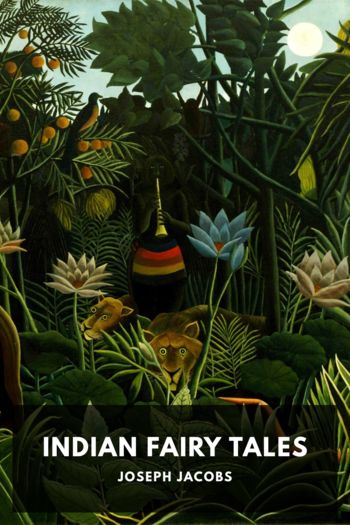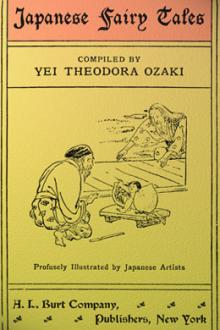Indian Fairy Tales by Joseph Jacobs (best books to read for students TXT) 📕

- Author: Joseph Jacobs
Book online «Indian Fairy Tales by Joseph Jacobs (best books to read for students TXT) 📕». Author Joseph Jacobs
Curiously enough, the negro form of the fivefold attack—“fighting with five fists,” Mr. Barr would call it—is probably nearer to the original legend than that preserved in the Jataka, though 2000 years older. For we may be sure that the thunderbolt of Knowledge did not exist in the original, but was introduced by some Buddhist Mr. Barlow, who, like Alice’s Duchess, ended all his tales with: “And the moral of that is—” For no well-bred demon would have been taken in by so simple a “sell” as that indulged in by Prince Five-Weapons in our Jataka, and it is probable, therefore, that Uncle Remus preserves a reminiscence of the original Indian reading of the tale. On the other hand, it is probable that Carlyle’s Indian god with the fire in his belly was derived from Prince Five-Weapons.
The negro variant has also suggested to Mr. Batten an explanation of the whole story which is extremely plausible, though it introduces a method of folklore exegesis which has been overdriven to death. The “Sasa Jātaka” identifies the Brer Rabbit Buddha with the hare in the moon. It is well known that Easterns explain an eclipse of the moon as due to its being swallowed up by a Dragon or Demon. May not, asks Mr. Batten, the “Pancavudha Jātaka” be an idealised account of an eclipse of the moon? This suggestion receives strong confirmation from the Demon’s reference to Rahu, who does, in Indian myth swallow the moon at times of eclipse. The Jataka accordingly contains the Buddhist explanation why the moon—i.e. the hare in the moon, i.e. Buddha—is not altogether swallowed up by the Demon of Eclipse, the Demon with the Matted Hair. Mr. Batten adds that in imagining what kind of Demon the Eclipse Demon was, the Jataka writer was probably aided by recollections of some giant octopus, who has saucer eyes and a kind of hawk’s beak, knobs on its “tusks,” and a very variegated belly (gasteropod). It is obviously unfair of Mr. Batten both to illustrate and also to explain so well the Tar Baby Jataka—taking the scientific bread, so to speak, out of a poor folk-lorist’s mouth—but his explanations seem to me so convincing that I cannot avoid including them in these Notes.
I am, however, not so much concerned with the original explanation of the Jataka as to trace its travels across the continents of Asia, Africa, and America. I think I have done this satisfactorily, and will have thereby largely strengthened the case for less extensive travels of other tales. I have sufficient confidence of the method employed to venture on that most hazardous of employments, scientific prophecy. I venture to predict that the Tar Baby story will be found in Madagascar in a form nearer the Indian than Uncle Remus, and I will go further, and say that it will not be found in the grand Helsingfors collection of folktales, though this includes 12,000, of which 1000 are beast-tales.
XXVI The Ivory PalaceSource.—Knowles, Folktales of Kashmir, pp. 211–25, with some slight omissions. Gulizar is Persian for rosy-cheeked.
Parallels.—Stokes, Indian Fairy Tales, No. 27. “Panwpatti Rani,” pp. 208–15, is the same story. Another version in the collection Baital Pachisi, No. 1.
Remarks.—The themes of love by mirror, and the faithful friend, are common European, though the calm attempt at poisoning is perhaps characteristically Indian, and reads like a page from Mr. Kipling.
XXVII Sun, Moon, and WindSource.—Miss Frere, Old Deccan Days, No. 10, pp. 153–5.
Remarks.—Miss Frere observes that she has not altered the traditional mode of the Moon’s conveyance of dinner to her mother the Star, though it must, she fears, impair the value of the story as a moral lesson in the eyes of all instructors of youth.
XXVIII How Wicked Sons Were DupedSource.—Knowles. Folktales of Kashmir, pp. 241–2.
Parallels.—A Gaelic parallel was given by Campbell in Trans. Ethnol. Soc., II p. 336; an Anglo-Latin one from the Middle Ages by T. Wright in Latin Stories (Percy Soc.), No. 26; and for these and points of anthropological interest in the Celtic variant see Mr. Gomme’s article in Folklore, I pp. 197–206, “A Highland Folktale and its Origin in Custom.”
Remarks.—Mr. Gomme is of opinion that the tale arose from certain rhyming formulae occurring in the Gaelic and Latin tales as written on a mallet left by the old man in the box opened after his death. The rhymes are to





Comments (0)